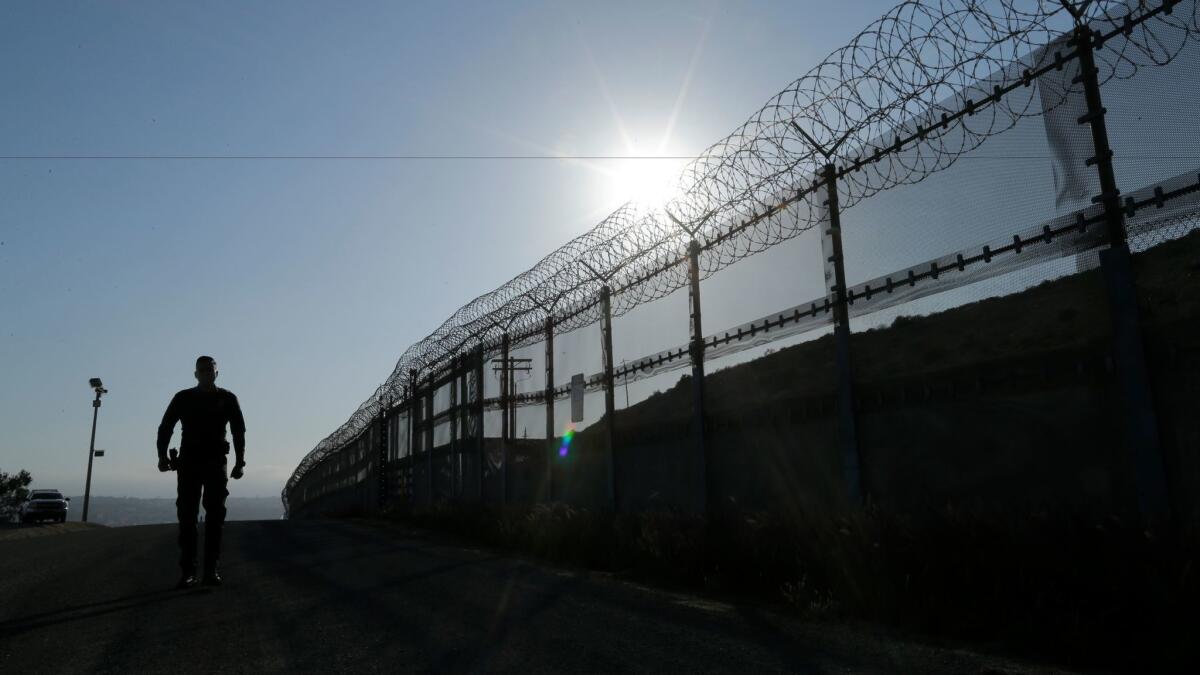Number of immigrants caught at Mexican border plunges 40% under Trump

The number of migrants caught by Border Patrol agents as they attempt to cross the Southwest border has plunged dramatically. (March 9, 2017)
Reporting from Atlanta — The number of immigrants caught by Border Patrol agents as they attempt to cross the Southwest border has plunged dramatically, dropping 40% since President Trump took office and signed sweeping executive orders to enforce immigration laws.
About 840 people a day were caught trying to cross the border or deemed inadmissible after presenting themselves at a port of entry in February, down from about 1,370 a day in January, according to new figures released by U.S. Customs and Border Protection.
Although there are often seasonal fluctuations — fewer immigrants usually attempt to cross the border from Mexico into the U.S. in winter — Border Patrol agents typically see a 10% to 20% surge of people making the journey in February.
Already, Trump’s supporters and leading members of his administration are celebrating the new data as an early payoff of the new president’s strident stance on illegal immigration.
“The early results show that enforcement matters, deterrence matters and that comprehensive immigration enforcement can make an impact,” Homeland Security Secretary John Kelly said, citing it as “encouraging news.”
“Fewer people are putting themselves and their families at risk of exploitation, assault and injury by human traffickers and the physical dangers of the treacherous journey north,” he added.
Although the drop is significant and larger than expected, migration policy experts say, it is too early to assume a long-term trend —particularly before many of the key measures of Trump’s executive orders have taken effect.
“What we’re seeing is really about perception,” said Faye Hipsman, a policy analyst at the Migration Policy Institute, a nonpartisan think tank based in Washington, D.C.: “The orders offer the possibility of very meaningful changes at the border — increased detentions, more people subject to rapid deportations — so that creates a perception that it’s more difficult to reach the United States. More importantly, there’s a lot of fear inside the U.S., and those feedback loops reach people who are thinking about making the journey.”
However, Hipsman cautioned, typically each time the government adopts new immigration enforcement measures — for example, building detention centers to accommodate the surge of Central American women and children — the numbers fall, only to rebound, in some cases higher than before.
While the new administration’s rhetoric on immigration enforcement may, in the short term, be a strong deterrent to people who are thinking of coming to the U.S., the long-term repercussions of Trump’s policies are not likely to be seen for months and years, said Jessica Vaughan, director of policy studies at the Center for Immigration Studies, a conservative Washington-based research institute that advocates stricter immigration policy.
In addition to installing more physical barriers, such as walls and fences, along the border, Vaughan said long-term success in deterring illegal immigration would depend on whether the federal government ended “catch and release,” the unofficial name for a policy in which immigration officials allow immigrants they deem low-risk to remain at large pending a hearing. It also would require stricter enforcement within the U.S., especially in workplaces, she said.
“When it’s much more difficult to get a job and live here legally, people will simply decide it’s not worth coming,” Vaughan said.
Advocates for immigrants say the data raise new questions about what is happening to immigrants crossing the border illegally, particularly asylum seekers — families and unaccompanied children fleeing poverty and violence in Central America and beyond.
The decline in the numbers of those migrants was especially extreme: An average of 442 families and unaccompanied children were caught crossing the border every day in January; that fell to 180 a day in February. And the number presenting themselves at a port of entry slowed from 107 a day to 47.
“We do not know where they are now,” said Amy Fischer, policy director at the Refugee and Immigrant Center for Education and Legal Services in San Antonio. “We know the conditions in their home countries have not changed drastically. Why are they not coming? That’s the key question here. We do not have the answers.”

Although it’s possible that asylum seekers are now looking for new and different avenues to win asylum, Fischer said, her organization had also seen evidence of efforts to turn people away at the border. A handful of people interviewed at family detention centers in Texas, she said, reported they had been turned away at the port of entry or told to come back another day before trying to cross the river.
“We don’t know if essentially what’s going on is an increase in the collusion between Mexican and U.S. authorities to turn people away at the border so they are not counted as apprehensions,” she said. “Throughout history, the U.S. has always been a safe place where people seeking protection can go. If that’s changing, look at what message that is sending to the rest of the world.”
In February, a total of 18,762 migrants were caught as they crossed or attempted to cross the Southwest border, compared with 31,578 in January, 43,255 in December and 47,210 in November. The number of people who presented themselves at ports of entry and were deemed inadmissible dropped to 4,808, compared with 10,899 in January, 15,176 in December and 16,153 in November.
The drop was stark at the busiest stretch of the border -- the Rio Grande Valley sector – which in recent years has seen a surge in families and unaccompanied children from Honduras, El Salvador and Guatemala. About 280 people a day were apprehended in the Rio Grande Valley in February, compared with 502 in January and 755 in December.
“When you start detaining people and deporting people, people stop coming in great masses,” Manuel Padilla, chief of the Border Patrol’s Rio Grande Valley sector, said in a telephone interview. “We’ve seen that historically throughout the years. We’re deporting people expeditiously, and just the fact that we’re doing that and the fact the administration is messaging that, they have quit coming in the same numbers.”
Already, numbers have dropped to the point that federal authorities have closed two multimillion-dollar, temporary holding facilities — one in Donna, Texas, near McAllen, and one in Tornillo, near El Paso — built just a few months ago to help provide temporary shelter to the influx of migrants crossing the border.
“After Jan. 20th, 22nd, you can very distinctly see the decrease in traffic because of the change in policy and executive orders,” Padilla said. (Trump was inaugurated on Jan. 20.) “If we continue in enforcing the immigration law and we continue building up the resources to detect and respond, I expect manageable numbers.”
Last year, border agents also saw an unprecedented spike in long-distance migrants making the journey from countries as far flung as Haiti, India, Bangladesh and parts of Africa. About 15,000 migrants from outside Latin America crossed through Baja California last year, nearly five times as many as in 2015.
Yet that number dropped dramatically in recent months, Hipsman said — not simply because of Trump’s executive orders, but because Obama’s administration tightened policy, expediting deportations to Haiti, at the end of 2016.
“In some ways, it’s not surprising that the numbers have dropped in response to the rhetoric by Trump’s administration,” Hipsman said. “But it’s far from certain that will be sustained.”
Jarvie is a special correspondent.
ALSO
San Francisco asks federal judge to block Trump order penalizing ‘sanctuary’ cities
At the Made in America Store, it’s a challenge to keep the aisles full
Fearful immigrants in U.S. make perilous winter crossing to seek protection in Canada
UPDATES:
3:55 p.m.: Updated with comment from the Center for Immigration Studies.
1:30 p.m.: This story has been updated with quotes and background, and adjusted figures from Customs and Border Protection.
This article was originally posted at 8:40 a.m.
More to Read
Sign up for Essential California
The most important California stories and recommendations in your inbox every morning.
You may occasionally receive promotional content from the Los Angeles Times.








